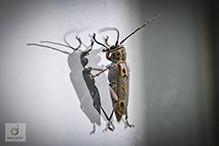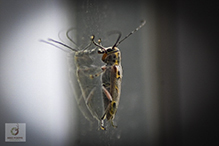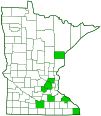elm borer
(Saperda tridentata)
Conservation • Description • Habitat • Ecology • Distribution • Taxonomy
Conservation Status |
|
|||||||
| IUCN Red List | not listed |
|||||||
| NatureServe | NNR - Unranked |
|||||||
| Minnesota | not listed |
|||||||
Description |
||
Elm borer is a small, flat-faced, long-horned beetle. It occurs in the United States east of the Great Plains and in adjacent Canadian provinces. It is found in deciduous woodlands that contain elm trees. Adults are active from May to August. Larvae feed on the inner bark of mostly American elm but also slippery elm and probably rock elm. The adult is 5⁄16″ to ⅝″ (8 to 17 mm) long. The body is slightly robust, moderately elongated, and broad-shouldered. The upper side of the head (vertex), the saddle-shaped exoskeletal plate covering the thorax (pronotum), and the hardened wing covers (elytra) are deeply pitted (punctate), are densely covered with short medium gray hairs, and have lines of bright reddish-orange hairs. The face is vertical and nearly flat. The compound eyes are deeply notched, with the bases of the antennae inserted in the notch. The antennae are long and have eleven segments. When held backward on the female they reach the sixth abdominal segment. On the male they reach beyond the end of the elytra. The upper side of the pronotum has a vertical line (stripe) on each side. Below each stripe there are two round black spots. Each elytron has a narrow stripe near the lateral margin, a thin stripe on the inner margin, and three cross lines (bands). The first band extends inward from the marginal stripe at right angles. It curves downward near the inner margin. The second and third bands are oblique, extending from the lateral stripe to the inner margin. There are two small black spots touching the first band and one small black spot touching the third band. The reddish-orange markings are variable, bold on some individuals, faint on some, moderate on most. The legs are long and orangish-gray. The last part of each leg (tarsus) has five segments, but the minute fourth segment is concealed by the enlarged third segment, making it appear to have just four segments. |
||
Size |
||
Total length: 5 ⁄16″ to ⅝″ (8 to 17 mm) |
||
Similar Species |
||
Habitat |
||
Deciduous woodlands |
||
Ecology |
||
Season |
||
May to August |
||
Behavior |
||
Adults are active mostly at night, and will come to lights. |
||
Life Cycle |
||
After mating, the female chews a slit into the bark and lays a single egg in the slit. In one month, she will lay 50 to 60 eggs, then she dies. When the egg hatches, the larva tunnels through and feeds on the outer bark. When it reaches the inner bark, it feeds on the cambium and phloem, creating a channel that meanders in all directions. In early August to mid-October, it forms a pupal cell ⅛″ to 5⁄16″ (4 to 8 mm) deep. It emerges as an adult in May or June or later depending on the weather. |
||
Larval Hosts |
||
American elm, slippery elm, and probably rock elm |
||
Adult Food |
||
Leaves, leaf stalks (petioles), and young twigs |
||
Distribution |
||||
|
Sources
|
|||
| 6/15/2022 | ||||
Occurrence |
||||
|
||||
Taxonomy |
|||
Order |
Coleoptera (Beetles) | ||
Suborder |
Polyphaga (Water, Rove, Scarab, Long-horned, Leaf, and Snout Beetles) | ||
Infraorder |
Cucujiformia | ||
Superfamily |
Chrysomeloidea (long-horned and allies) | ||
Family |
Cerambycidae (longhorn beetles) | ||
Subfamily |
Lamiinae (flat-faced longhorn beetles) | ||
Tribe |
Saperdini | ||
Genus |
Saperda | ||
Synonyms |
|||
Saperda intermedia Saperda rubronotata Saperda trifasciata |
|||
Common Names |
|||
elm borer |
|||
Glossary
Cambium
A thin layer of soft growing tissue composed of unspecialized cells in the stems of plants. It provides new xylem to the inside and new phloem to the outside.
Elytra
The hardened or leathery forewings of beetles used to protect the fragile hindwings, which are used for flying. Singular: elytron.
Petiole
On plants: The stalk of a leaf blade or a compound leaf that attaches it to the stem. On ants and wasps: The constricted first one or two segments of the rear part of the body.
Pronotum
The exoskeletal plate on the upper side of the first segment of the thorax of an insect.
Punctate
Dotted with pits (punctures), translucent sunken glands, or colored spots of pigment.
Vertex
The upper surface of an insect’s head.
Visitor Photos |
|||||
Share your photo of this insect. |
|||||
| This button not working for you? Simply email us at info@MinnesotaSeasons.com. Attach one or more photos and, if you like, a caption. |
|||||
Mike Poeppe |
|||||
 |
 |
||||
MinnesotaSeasons.com Photos |
|||||
|
|||||

Slideshows |
||

Visitor Videos |
|||
Share your video of this insect. |
|||
| This button not working for you? Simply email us at info@MinnesotaSeasons.com. Attach a video, a YouTube link, or a cloud storage link. |
|||
Other Videos |
|||
| ELM BORER, Saperda tridentata feeding 3022487 Rob Curtis |
|||
About
Aug 15, 2020 ELM BORER, Saperda tridentata feeding. Chicago, 8/2/2020 3022487 |
|||

Created: 6/15/2022
Last Updated:


